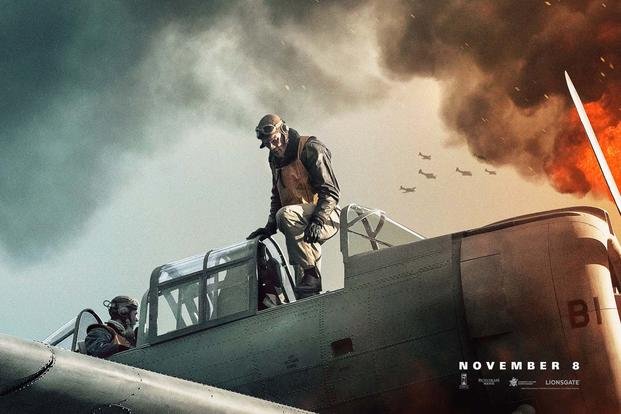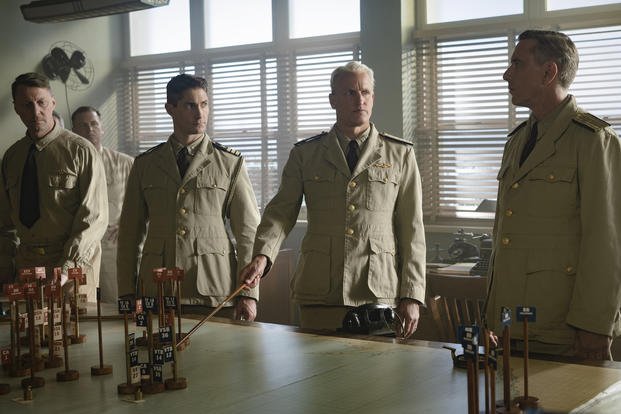No disrespect to the brave soldiers who landed at Normandy on D-Day, but telling the story of men fighting on the ground with guns is a far less daunting challenge for movie makers than telling a detailed story about the air and sea battles in the Pacific. Screenwriter Wes Tooke and director Roland Emmerich may just have cracked the code with "Midway," their epic new retelling of what's arguably the most important battle in American history.
Wes Tooke made his name as a writer and producer on the USA sci-fi series "Colony," but he's been working with noted action director Emmerich ("Independence Day") for years to bring this story to the screen. Emmerich is one of the masters of using special effects in mainstream cinema and he takes the things he learned from science fiction and adapted them to an even more incredible true story.
Tooke spoke with us about the film's journey to the screen and how he worked out how to distill an incredibly complex story down to a wickedly effective two-hour movie.

Military.com: Do you have a connection to the story of Midway?
Wes Tooke: I come from a naval family. My grandfather was [U.S. Naval Academy] Annapolis class of 1927, which means that he was that at the same time as Eugene Lindsey, who's played by Darren Criss in the movie. What that gave me was an appreciation for what a small fraternity of guys really was as we were going into the second world war.
Between the first and second world war, the graduating classes at Annapolis got really small, down to about 500 people. When the war broke out, if the ship went down, you almost certainly knew someone on board. So I had this appreciation for what it must've been like to be part of that small fraternity of men trying to hold the line in the face of what felt like insurmountable forces as they waited for the cavalry to arrive once the draft started up again.
Those men on the frontline paid an incredible price over the first year and a half of the war.
I grew up fascinated by the era, but unfortunately a lot of us didn't talk to our grandparents enough about what happened in the war. Obviously a lot of those veterans didn't want to talk about what they'd done. My own grandfather died in the late nineties. I did some research and discovered that he may have been at the Bureau of Ships and helped design the USS Enterprise in the mid-1930s. So my grandfather may have helped build the ship that is the center of our story.
Military.com: How long have you been trying to tell this story?
WT: It goes back a lot of years. To me it's the greatest military comeback story in history. You have a fleet that has devastated and everyone presumes the battleships are the heart of the fleet and they're all lying at the bottom of Pearl Harbor .
Just six months later, somehow the Navy managed to turn it around and really turn the tide of the war because of this remarkable battle. As a kid, I actually made a diorama of it as my seventh-grader school project. Some kids had comic books. I was always just the kid who was flipping through "Jane's Fighting Ships" and obsessed with military history.
I was working on another project with Roland's company. We were having lunch and I just asked him, "What is the project that got away?" He explained that he had always been obsessed with Midway and felt like that the advances in digital technology, the effects technology, were finally going to make it possible to show the battle in a way that we'd never seen before.
That was music to my ears. In the original "Midway" film, they had to rip the footage from previous films like "Tora!, Tora!, Tora!" I just remember being a kid and trying to picture what these battles would be like. We didn't even really have a firm sense of what the Japanese carriers looked like.
Related: 7 Weird Facts About the 1976 Movie 'Midway'
The idea of being able to make all that come alive and make people appreciate what it must've been like to be in a cockpit of a dive bomber with Zeros in your tail. We spend so much time and money on comic book movies. Why not make a movie about real heroes that uses that same type of technology to allow a modern audience to appreciate what these men went through?

Military.com: I can't imagine this film being made five years ago or 10 years ago.
WT: No, certainly not for the price. We weren't working with Marvel money. One thing that's easier for Marvel movies is that no one really knows what an alien spaceship looks like, but our eye does kind of know what a plane looks like and what an aircraft carrier looks like. The bar for making sure that this stuff doesn't just look like a video game is really, really high.
We had two [visual effects] houses doing the effects and they had a huge challenge. Given the resources and time they had to work with that they did, did a really remarkable job.

Military.com: How did you manage to tell the story in two hours? If I'd tried to write it, I would've ended up with a three-season HBO series.
That was the challenge of the stories. It really deserves a 20- to 40-hour miniseries. There are so many heroes and so many things that are too remarkable to be believed. To cram it into a two hour movie almost feels like it's impossible exercise.
But if you're going to do it, you kind of need to focus on a handful of characters and make sure their stories are relatable. At the beginning of this process I just was reading every possible book I could find about Midway.
I stumbled on this one paragraph about Dick Best and then started trying to find him in every other book because of that one paragraph about his story. Here's the guy who sing basically single-handedly put one of the four Japanese carriers out of action. He went back later in the day and hit a second carrier despite the fact that he had torn up his lungs and was coughing blood and would never fly again.
If you're trying to distill the story of heroism on this day into one single storyline of what it's like to be a dive-bomb pilot and go out in the face of impossible odds and put your life on the line, then Dick Best would be your guy.

Military.com: The fact that you're able to focus on the men who fought the battle was one of my favorite things about the movie. I've said that most World War II moves are the story of old men pointing at maps. You were really able to show what it was like in the teeth of battle.
WT: No, you're absolutely right. Economically you just simply couldn't do it before. You had to buy space for your five minutes of action sequence with 90 minutes of (as you're saying) old men pointing at maps.
That's the difference of this film which made it an interesting challenge. How do you balance the action and still make people understand the confluence of circumstances that made the miraculous outcome to this battle possible?
If you were writing this movie as a fictional narrative, there are so many coincidences people would doubt. They just seem too impossible to be believed, but you need to make sure that they get into the story because they are what makes the story so fascinating.

Military.com: After the screening I attended, I tried to speak with people who didn't know the history as well as I did, just to make sure they could follow the story. Everyone reported that they could understand what was going on all the way through the movie. That's impressive. How did you distill this sprawling story down to two hours?
WT: It was like this giant jigsaw puzzle. When I began, it looked like I was trying to track the Zodiac killer. I had a wall with cards that showed every major event in the battle. I just stood in front of it for weeks trying to figure out how to pare it down.
I ultimately realized that the Dick Best dive bombing story was one story that could make it work. We needed to tell the Japanese side of it because it's when you include their side that you end up with this epic, classic throwback of a film. The movie wouldn't feel modern if you didn't properly recognize that there was and heroism and tragedy on their side as well.
Finally, how do you also tell the codebreaking story? With each of them roughly one third of the movie, how do you fit that into two hours? That was certainly why it took so many years to develop the movie because you have to make people emotionally engaged by the end of the movie. You're not just making a documentary, you're telling something about the real human beings who put themselves on the line.
















